Chiroteuthis calyx
Clyde F. E. Roper and Richard E. YoungIntroduction
C. calyx is known only from the temperate waters of the North Pacific. It is closely related to C. veranyi but is easily separated by the presence of globular arm suckers and differences in the structure of the proximal section of the protective membranes on the tentacular club.
Brief diagnosis:
A Chiroteuthis ...
- with short club divided into two nearly equal sections by protective membranes.
- with trabeculae, in the proximal protective membrane of the club, not fused at bases and divided at tips.
- with photophores on eyeball in stripes and discs, and two photophores on viscera.
Characteristics
- Arms
- Largest suckers with nearly smooth rings, proximal suckers with 18-20 separate, truncate teeth on distal 2/3 of ring.
- Largest suckers globular; largest suckers on arms III more than three times diameter of adjacent arm IV suckers.
- Tentacular clubs
- Suckers with 11-14 pointed teeth, with bases in contact, over distal 1/2-3/4 of ring; central tooth enlarged.
- Sucker stalks in two distinct parts (stalk diameters differ); stalks of suckers in lateral series much longer than those in medial series.
- Protective membranes
- Membranes in two distinct sets of about equal lengths, proximal set slightly broader.
Figure. Aboral view of the tentacular club of C. calyx. Drawing from Young (1972).
- Proximal set with separate trabeculae (approx. 17), each split distally into two or three parts, except for initial one or two.
- Distal set with about 18 single, separate trabeculae.
- Membranes in two distinct sets of about equal lengths, proximal set slightly broader.
- Head
- Beaks: Descriptions can be found here: Lower beak; upper beak.[id=5701]
- Photophores
- Eyeball: lateral series = stripe; medial series = stripe; intermediate series = one large round anterior, one large round posterior photophore and one small round photophore offset slightly medially near anterior photophore.
- Viscera: two photophores on ink sac.
- Pigmentation
- Club sucker stalks pleated, otherwise stalks unpigmented.
Comments
More details of the description are found here.Nomenclature
This species was originally described by Young (1972) for squids taken off Oregon, California and Baja California. Prior records of C. calyx (e.g., Berry, 1963; Pearcy, 1965) in these waters had been referred to C. veranyi, its close relative.
Life history
Paralarval stages are typical for the family. The late doratopsis paralarval stage attains a length of at least 60 mm ML (Berry, 1963). Paralarval behavior has been described by Vecchione, et. al., 1992. They suspect that the peculiar paralarval tail is used to mimic an unpalatable siphonophore and thereby gain protection from predators.
The evidence for this idea can be seen in this MBARI video and was described in this paper.

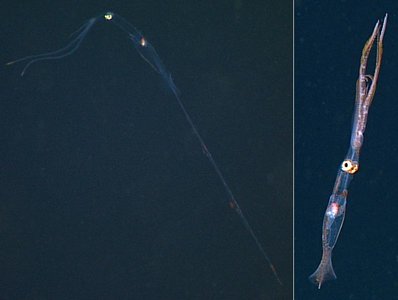
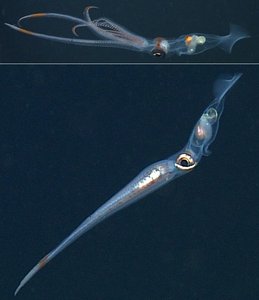
Figure. Growth of C. calyx. Left - Paralaraval stage. Left middle - Recent juvenile still with long neck and long brachial pillar. The different colors on the clubs suggest that the adult and doratopsid clubs may both be present. Right top - Young subadult with much shorter brachial pillar and neck. Th Right bottom - Subadult with brachial pillar virtually gone and very short neck. The silver reflection from within the arm crown of the latter is a captured myctophid fish. Insitu photographs © 2011 MBARI.
Distribution
Geographical distribution
Type locality - off Southern California. This species is found throughout the North Pacific Transition Zone from off Southern California to the Gulf of Alaska, across the North Pacific to off Honshu, Japan (Nesis, 1982; Seki, in prep.).
References
Berry, S. S. 1963. A “Doratopsis” larva of the squid family Chiroteuthidae in Californian waters. Calif. Fish. Game, 49: 128-139.
Burford, B. P., Robison, B. H., & Sherlock, R. E. (2015). Behaviour and mimicry in the juvenile and subadult life stages of the mesopelagic squid Chiroteuthis calyx. Journal of the Marine Biological Association of the United Kingdom, 95(6), 1221-1235.
Pearcy, W. 1965. Species composition and distribution of pelagic cephalopods from the Pacific Ocean off Oregon. Pac. Sci., 19: 261-266.
Vecchione, M., B. H. Robison, and C. F.E. Roper. 1992. A tale of two species: tail morphology in paralarval Chiroteuthis (Cephalopoda: Chiroteuthidae). Proceeding of the Biological Society of Washington 105(4): 683-692.
Young, R. E. (1972). The systematics and areal distribution of pelagic cephalopods from the seas off Southern California. Smithson. Contr. Zool., 97: 1-159.
Title Illustrations

| Scientific Name | Chiroteuthis calyx |
|---|---|
| Reference | from Young, R. E. 1972. The systematics and areal distribution of pelagic cephalopods from the seas off Southern California. Smithson. Contr. Zool. 97:1-159. |
| Size | 54 mm ML |
| Image Use |
 This media file is licensed under the Creative Commons Attribution License - Version 3.0. This media file is licensed under the Creative Commons Attribution License - Version 3.0.
|
| Copyright |
©

|
About This Page

Smithsonian Institution, Washington, D. C., USA

University of Hawaii, Honolulu, HI, USA
Page copyright © 2019 and
All Rights Reserved.
- Content changed 26 March 2019
Citing this page:
Roper, Clyde F. E. and Richard E. Young. 2019. Chiroteuthis calyx . Version 26 March 2019 (under construction). http://tolweb.org/Chiroteuthis_calyx/19474/2019.03.26 in The Tree of Life Web Project, http://tolweb.org/




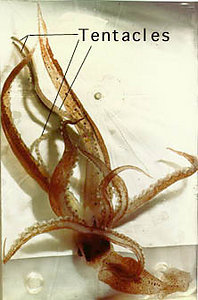
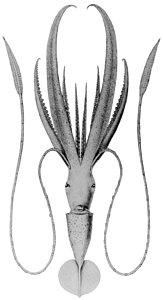

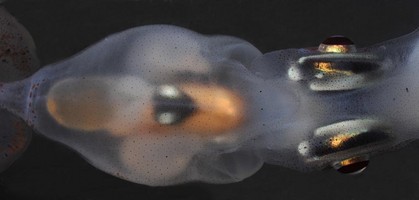
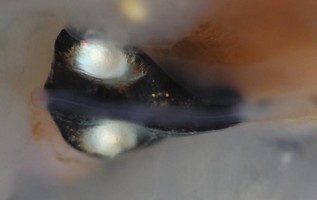




 Go to quick links
Go to quick search
Go to navigation for this section of the ToL site
Go to detailed links for the ToL site
Go to quick links
Go to quick search
Go to navigation for this section of the ToL site
Go to detailed links for the ToL site